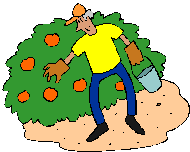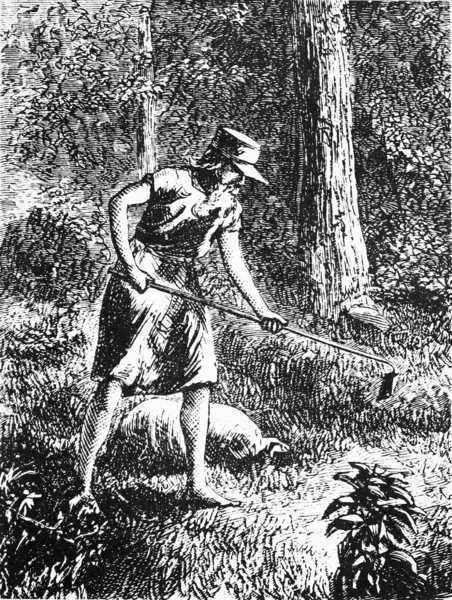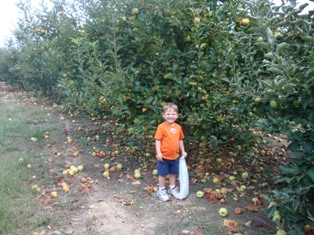
Looking for Johnny Appleseed - John Chapman - Facts in 2025? Scroll down this page and follow the links. And if you bring home some fruit or vegetables and want to can, freeze, make jam, salsa or pickles, see this page for simple, reliable, illustrated canning, freezing or preserving directions. There are plenty of other related resources, click on the resources dropdown above. If you are having a hard time finding canning lids, I've used these, and they're a great price & ship in 2 days.
If you have questions or feedback, please let me know! There are affiliate links on this page. Read our disclosure policy to learn more.
Johnny Appleseed - John Chapman - Facts
Johnny Appleseed - John Chapman - Facts
Johnny Appleseed's real name was John Chapman and he lived from September 26, 1774 to March 18, 1845.
Chapman/Appleseed was an American pioneer planted groves of apple trees in large parts of what was then the western frontier: Pennsylvania, Ontario, Ohio, Indiana, and Illinois, and the northern counties of West Virginia. He was well-known while he was alive, considered to be generous and kind, and of course, planting apples. You may not know he was also a missionary for The New Church (Swedenborgian)
Planting apples
Johnny Appleseed didn't plant apple seeds randomly; he actually planted nurseries and built fences around them to protect them from livestock grazing on the seedlings. He would leave the nurseries in the care of a local person. This person could sell some of the trees and kept some of the profit, while returning some to Chapman to plant more trees. Chapman would return to the nurseries every year or two to check on them.
His first nursery was located on the bank of Brokenstraw Creek, south of Warren, Pennsylvania. From there he moved to Venango County, and then north-central Ohio.
One odd fact is that he opposed to grafting apples, which combines a sturdy apple rootstock with a very good eating apple on top. As a consequence, the apples he planted were most fit for making apple cider... and apple whiskey!
Smithsonian Magazine says:
The apples that Chapman brought to the frontier were completely distinct from the apples available at any modern grocery store or farmers' market, and they weren't primarily used for eating; they were used to make America's beverage-of-choice at the time, hard apple cider.
His life
John Chapman was born in Leominster, Massachusetts, on September 26, 1774. His father was Nathaniel Chapman who served as a minuteman at the Battle of Concord, and later served in the Continental Army under General George Washington.
Chapman preached the gospel as he traveled, and including to audiences of Native Americans. There seemed to be mutual respect between Chapman and the Native Americans who regarded him as someone who had been touched by the Great Spirit.
He was an early environmentalist and conservationist. There are anecdotes that he had a pet wolf that had started following him after he healed its injured leg and rescued a horse was to be put down, and gave the horse to someone needy, exacting a promise to treat it humanely.
He even became a vegetarian later in his life.
He never married and had no children.
Different dates are listed for his death, but March 18, 1845 is generally accepted, making him about 80 years old. This despite that he was frequently barefoot and wore a metal pot on his head (which he also used for cooking).
According to Wikipedia, "The site of his grave is also disputed. Developers of the Canterbury Green apartment complex and golf course in Fort Wayne, Indiana, claim that his grave is there, marked by a rock. That is where the Worth cabin sat in which he died.[21]41°6′36″N 85°7′25″ "
References
More Apple Facts and Fun!
- A bushel of apples typically weighs between 42 and 48 lbs.
- Apples are grown commercially in 36 states.
- Apples are grown in all 50 states.
- Europeans eat about 46 pounds of apples annually.
- United States consumers ate an average of 45.2 pounds of fresh apples and processed apple products. That's a lot of applesauce!
- 61 percent of United States apples are eaten as fresh fruit.
- 39 percent of apples are processed into apple products; 21 percent of this is for juice and cider.
- The top apple producing states are Washington, New York, Michigan, California, Pennsylvania and Virginia, which produced over 83 percent of the nation's 2001-crop apple supply.
- Apples are a great source of the fiber pectin. One apple has five grams of fiber.
- In 2001 there were 8,000 apple growers with orchards covering 430,200 acres. (don't know how many of those are PYO).
- The pilgrims planted the first United States apple trees in the Massachusetts Bay Colony.
- Apple trees take four to five years to produce their first fruit, but you normally buy 2 or 3 year plants at the nursery, so it's only 2 years till they produce!
- Most apples are still picked by hand in the fall.
- Apple varieties range in size from a little larger than a cherry to as large as a grapefruit.
- In Europe, France, Italy and Germany are the leading apple producing countries.
- Apples are a member of the rose family.
- Apples harvested from an average tree can fill 20 bushel boxes that weigh 42 pounds each.
- 25 percent of an apple's volume is air. That is why they float.
- It takes the energy from 50 leaves to produce one apple.
- Apples are the second most valuable fruit grown in the United States. Oranges are first.
- In colonial time apples were called winter banana or melt-in-the-mouth.
- China is the leading producer of apples with over 1.2 billion bushels grown in 2001. The U.S. is number 2 and then Turkey, Poland and Italy.
- Newton Pippin apples were the first apples exported from America in 1768, some were sent to Benjamin Franklin in London.
- One of George Washington's hobbies was pruning his apple trees.
- America's longest-lived apple tree was reportedly planted in 1647 by Peter Stuyvesant in his Manhattan orchard and was still bearing fruit when a derailed train struck it in 1866.
- A bushel of apples weights about 42 pounds (up to 48 lbs) and will yield 12 to 15 quarts of applesauce.
- It takes about 36 apples to create one gallon of apple cider.
It's all about the variety!
Of the apple, that is. There are
- 2500 varieties of apples are grown in the United States.
- 7500 varieties of apples are grown throughout the world.
- About 100 different varieties of apples are grown commercially in the United States.
You really need to choose the type of apple that is best suited for your purpose. Apples can be suited for eating fresh, cooking, baking, applesauce, storing, etc. I have a fairly extensive guide to apple varieties here!
The top ten apple varieties currently grown in the United States are:
- Red Delicious
- Gala
- Golden Delicious
- Fuji
- Granny Smith
- McIntosh
- Honeycrisp
- Rome
- Empire
- Cripps Pink
Apple nutrition facts
- Nutrition and miscellaneous facts: One-half cup of apples is only 42 calories. Apples contain no cholesterol or fat and are also low in calories. T Apples are high in dietary fiber, Vitamin A and niacin. They contain iron and other trace minerals and are a fair source of Vitamin C.
- Apples are ranked No. 1 in antioxidant activity compared with 40 other commercially available fruits and vegetables. That means a serving of apples has more of the antioxidant power you need to fight aging, cancer and heart disease.
- Put this in your pipe! Indians in the Northwest Territory smoked wild apples to preserve them for the winter. (Bet you didn't know that!)
Canning apples - fully illustrated, with step-by-step instructions
- How to make applesauce
- How to make apple butter
- NEW: How to make apple jelly
- How to make apple pie filling (canned)
- How to can apples
Recipes, illustrated with step by step instructions
- Apple pie recipe and directions and illustrated! I can say, with, ahem, no bias at all, that this is the best apple pie recipe in the world! (Alright, I did have an apple strudel in Vienna once at that place listed in Fodors that was REALLY good, but that wasn't a pie, was it? And since this was the recipe my grandmother used, it must be great!)
- How to make applesauce for a single meal (not canning it) with NO special equipment
- Apple crunch - best of all! Moist, low sugar and using oats!
- Apple crisp - ever-popular, low sugar and using oats!
- Apple, blackberry, cherry, and/or peach cobbler
- Apple-blackberry, crumble - a English favorite (or favourite)
- And the many apple associations listed on this page have more facts and resources
Current Season (2025) Apple News
The U.S. Apple Association's estimate of the size of the 2014 United States apple crop is 263.8 million bushels. The USDA's August 12th estimate was for 259.2 million bushels.
See this page for much more detailed information about the apple crop and apple production trends.
Apples-Average retail price per pound and per cup equivalent
Apple Festivals
Here is a list of major apple festivals in the U.S., Britain, Australia and other countries. If you know of any more, please write me! Feedback
Looking for canning equipment and supplies?
Water bath canner with a jar rack
Pressure canners for gas, electric and induction stoves: Presto 23Qt or T-fal 22Qt
Canning scoop (this one is PERFECT)
Ball Blue book (most recent version)
Jars: 8oz canning jars for jams
Find Other types of farms:
Farm markets and roadside stands
Road trips and camping resources
Local Honey, apiaries, beekeepers
Consumer fraud and scams information
Home canning supplies at the best prices on the internet!
Maple Syrup Farms, sugarworks, maple syrup festivals
Environmental information and resources
Farms For Your Event for birthday parties, weddings, receptions, business meetings, retreats, etc.
Festivals - local fruit and vegetable festivals
Get the
most recent version of
the Ball Blue Book
With this Presto 23 quart pressure canner and pressure cooker, you can "can" everything, fruits, vegetables, jams, jellies, salsa, applesauce, pickles, even meats, soups, stews. Model 01781

You can make jams, jellies, can fruit, applesauce, salsa and pickles with water bath canners, like this Granite Ware 12-Piece Canner Kit, Jar Rack, Blancher, Colander and 5 piece Canning Tool Set

